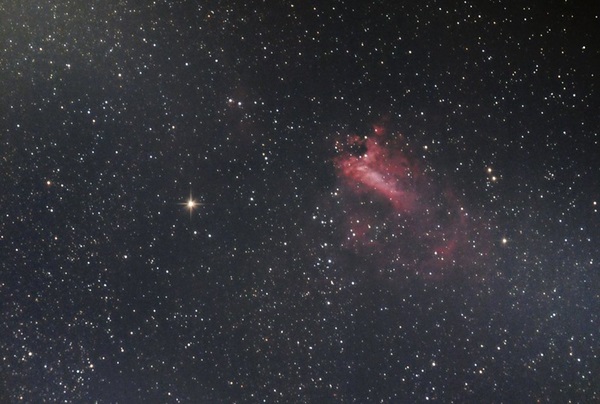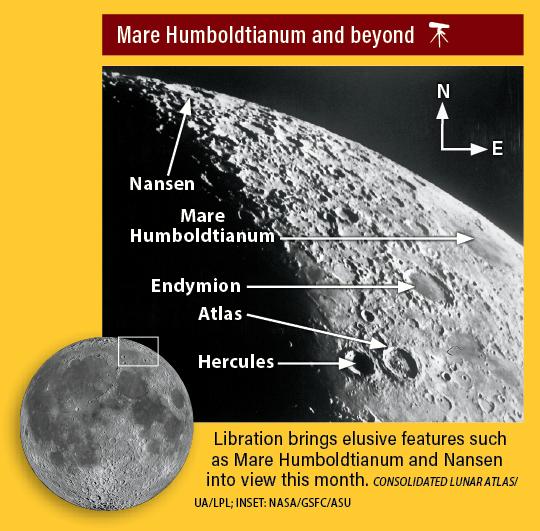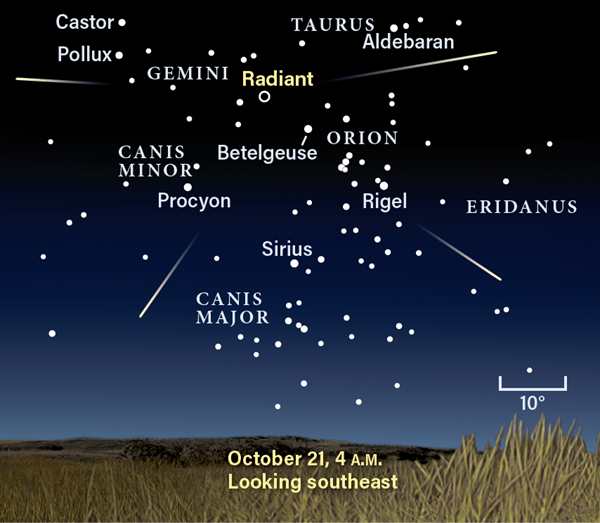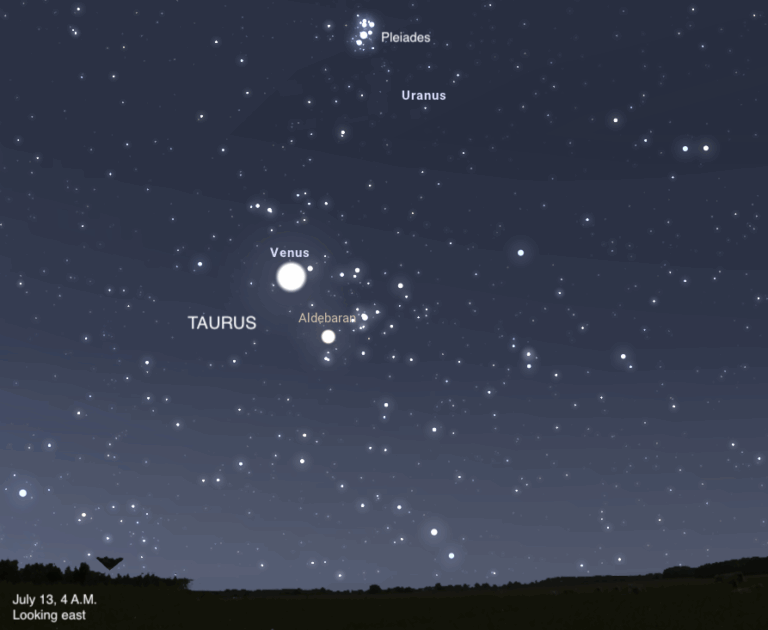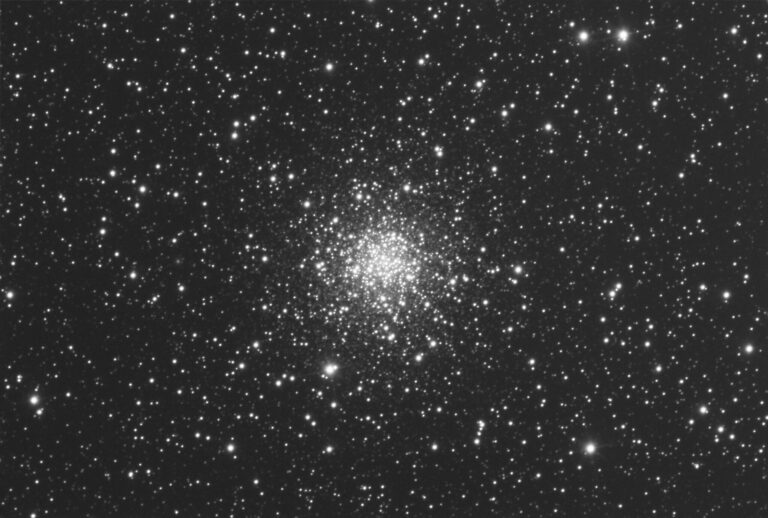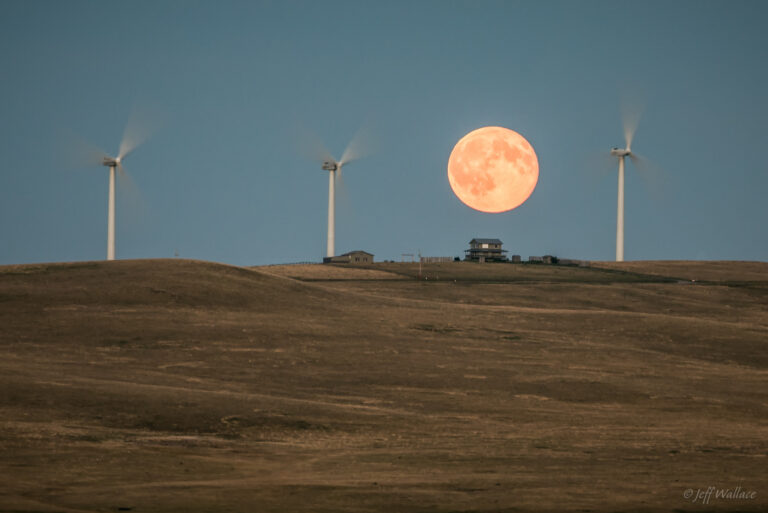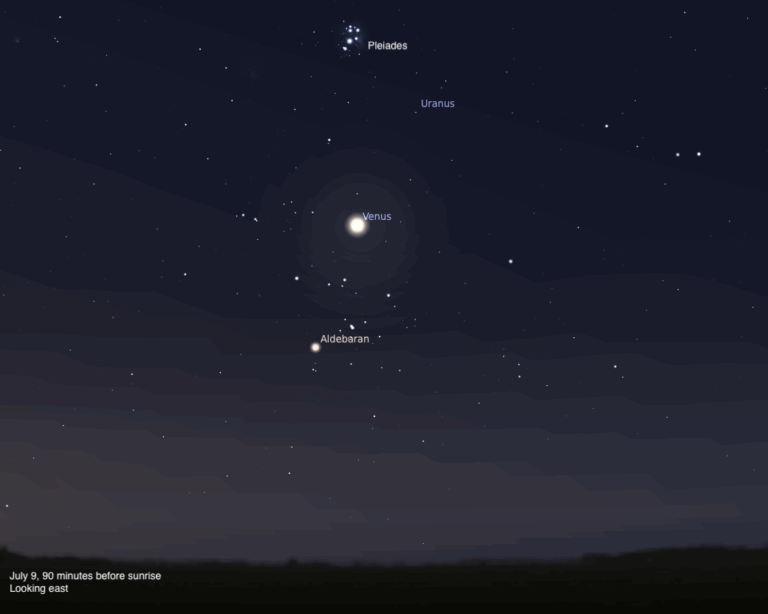Key Takeaways:
New Moon occurs this afternoon at 3:31 P.M. EDT. Our satellite is also at perigee, the closest point in its orbit around our planet, and currently sits just 221,775 miles (356,912 kilometers) from Earth.
Take advantage of the dark skies tonight for some deep-sky observing. About two hours after sunset, the plane of the Milky Way stands straight up from the southwest horizon. Numerous star clusters, both young and old, dot the region. Focus in on the area northwest of Sagittarius’ Teapot asterism, which tonight appears to be pouring down toward the ground. In the area to the right of its lid, you’ll find objects that include nebulae: M8 (Lagoon Nebula), M20 (Trifid Nebula), M17 (Omega or Swan Nebula); star clouds: M24; and open clusters: M23, M18.
All should be visible with binoculars under good conditions, and a telescope will bring out even more detail. The region starts to set around 9:30 P.M. local time, however, so make sure you’re ready to go as darkness falls to truly enjoy these treats.
Sunrise*: 7:12 A.M.
Sunset: 6:18 P.M.
Moonrise: 6:46 A.M.
Moonset: 6:38 P.M.
Moon Phase: New (0%)
*Times for sunrise, sunset, moonrise, and moonset are given in local time from 40° N 90° W. The Moon’s illumination is given at 12 P.M. local time from the same location.
The Moon passes 7° north of Mercury at 3 P.M. EDT. Our solar system’s smallest, speediest planet is heading toward inferior conjunction on the 25th. Tonight, it shines at magnitude 1.5 and sits nearly 5.3° southwest of the crescent Moon just 10 minutes after sunset. At that time, the planet is just 2° high, so only observers with a clear view of the western horizon have a chance of spotting it. If you try with binoculars, take care to ensure the Sun is below the horizon before you pull them out. Otherwise, it’s too easy to accidentally catch our star’s glare in your binoculars and cause permanent damage to your eyes.
The Moon sets shortly after, and it’s another clear, dark night to scan for deep-sky wonders. Tonight, follow the plane of the Milky Way from Sagittarius to Cygnus, high overhead. Its familiar cross shape should be easy to find, with bright Deneb at one end and the brilliant double star Albireo at the other. Deep-sky objects you’ll find within this flying constellation include the North America Nebula (NGC 7000), open clusters M39 and M29, and the stunning Veil Nebula supernova remnant (NGC 6960), which sits near the 4th-magnitude star 52 Cygni. The first three are visible with binoculars, but the last you’ll need a telescope to see — ideally with a 6-inch aperture or larger. If possible, slide on an OIII filter to make its gauzy detail even easier to discern.
Sunrise: 7:13 A.M.
Sunset: 6:16 P.M.
Moonrise: 8:04 A.M.
Moonset: 7:12 P.M.
Moon Phase: Waxing crescent (1%)
Sunday, October 18
Although it reached opposition last week, Mars remains a great evening target for the rest of the month. Because it rises around sunset, the later you wait, the better — the higher the Red Planet sits in the sky, the clearer and steadier the image you’ll get will be. Tonight, Mars shines at magnitude –2.5 and appears nearly 22″ across. It’s still less than half the average Earth-Sun distance from our planet, although its closest approach was now two weeks ago and our planets will slowly separate further over time.
In the hours before midnight, pull out your scope and see if you can identify the bright spot of Olympus Mons. This huge shield volcano is more than twice the height of Earth’s Mount Everest and is nearly 400 miles (640 km) in diameter. Also visible to the volcano’s south is the large, dark splotch of Mare Sirenium. As the hours pass into Monday morning, Mare Cimmerium rotates into view. Mars will remain visible all night, a bright orange beacon amid the dimmer stars of Pisces.
Sunrise: 7:14 A.M.
Sunset: 6:15 P.M.
Moonrise: 9:22 A.M.
Moonset: 7:49 P.M.
Moon Phase: Waxing crescent (6%)
Starting today, a common and intriguing effect of the Moon’s orbit around Earth — libration — is on display. Tonight and over the next few evenings, pull out binoculars or a telescope at dusk to observe our only natural satellite. Pay special attention to the northeast (upper right) portion of the disk, where features not normally visible will pop out with ease: Mare Crisium near the lunar equator and, to its northeast, Mare Humboldtianum. Just north of Humboldtianum is the crater Nansen, named for a Norwegian polar explorer. Under high magnification, you should be able to see the dark shadow cast into the crater by its high rim.
Over the next few nights, these features will shift back toward the limb. Although it may seem counterintuitive, it’s easiest to see this shift occur if you look at the Moon with the naked eye during daylight. Zoom back in on the region with binoculars or a telescope, and you’ll more easily see Mare Humboldtianum turn back into profile.
Sunrise: 7:16 A.M.
Sunset: 6:14 P.M.
Moonrise: 10:38 A.M.
Moonset: 8:31 P.M.
Moon Phase: Waxing crescent (12%)
Tuesday, October 20
Comet 88P/Howell floats less than 1° northeast of the open star cluster NGC 6520 tonight. You’ll want to catch the pair in Sagittarius, just above the Teapot’s spout, relatively early in the evening. Use a 4-inch scope or larger, depending on the amount of light pollution nearby.
It’s a bit of a study in light and dark — magnitude 9 NGC 6520 lies adjacent to the dark cloud Barnard 86. The star cluster is just east of this inky smudge, which looks almost like a hole on the sky. What’s actually happening is the cloud, made of cool dust, is simply blocking the light from the rich starfield behind it.
Tonight, there’s even a bonus: For better or worse, the waxing Moon lies just next door (northwest) in the constellation Ophiuchus.
Later tonight, the Orionids are ramping up; as the Moon sets, the shower’s radiant is rising. Stick around overnight or set your alarm for early tomorrow morning to catch the best part of the show.
Sunrise: 7:17 A.M.
Sunset: 6:12 P.M.
Moonrise: 11:52 A.M.
Moonset: 9:21 P.M.
Moon Phase: Waxing crescent (21%)
The Orionid meteor shower peaks early this morning. At that time, the Moon nowhere in sight and the shower’s radiant, which sits in northern Orion, is high in the sky. Look for the familiar figure of the Hunter in the south and locate his right shoulder (on the left side of the constellation), marked by the bright red giant Betelgeuse. A little less than 3° northeast of Betelgeuse is magnitude 4 Mu (μ) Orionis; follow a line drawn between these two stars about 7° farther northeast from Mu, and you’ll run smack dab into the Orionids’ radiant.
The shower’s predicted maximum rate is roughly 20 meteors per hour, and that rate grows more likely in the hours before dawn. Orionids are fast-paced meteors, skipping through the atmosphere at roughly 41 miles (67 kilometers) per second. And they have a famous parent: The Orionids are the result of dust and debris shed by Comet 1P/Halley as it flies near the Sun.
Although the shower’s maximum occurs this morning, its activity will last into early November. Vigilant skywatchers are likely to catch increased rates of meteors over the next few nights at least, and likely well into next month.
Sunrise: 7:18 A.M.
Sunset: 6:11 P.M.
Moonrise: 12:57 P.M.
Moonset: 10:16 P.M.
Moon Phase: Waxing crescent (31%)
Thursday, October 22
The Moon passes 2° south of Jupiter at 1 P.M. EDT this afternoon; our satellite then passes 3° south of Saturn at midnight tonight. Sagittarius is a popular place this week, as you’ll find our Moon hanging with the giant planets there this evening, northeast of the Teapot’s handle as soon as the Sun goes down. About an hour after sunset, the Moon appears suspended between them. Jupiter, to our satellite’s right, glows a bright magnitude –2.3. Saturn, on the left, is around magnitude 0.6. The two planets sit a little less than 6° apart. Over the next few months, that distance will shrink until they seem to nearly merge on the sky during their Great Conjunction in December.
All four of Jupiter’s Galilean moons are visible for most of the evening: Ganymede, Europa, and Io (closest to the planet) stretch out to its east, and Callisto to its west. Shortly after 11:30 P.M. EDT, Io crosses onto the planet’s face and begins a transit that will last a little over two hours. By the time Io slips away from the planet, now on its western side, the dark blot of the tiny moon’s shadow has followed it nearly halfway across.
Over at Saturn, the rings are on display. Low power should also reveal its biggest, brightest moon, Titan, about 2′ due east of the planet tonight. Higher magnification will likely bring out detail on the planet and perhaps even the reveal its shadow on the eastern side of the rings.
Dwarf planet Ceres is stationary tonight at 11 P.M. EDT. It lies above the southern horizon in the constellation Aquarius. Large binoculars or a small scope will find it. The easiest way to locate Ceres is to first find Fomalhaut, the brightest star in Piscis Austrinus. From there, scan 4.5° northwest to Epsilon (ε) Piscis Austrini, and then look northwest the same distance again to find Ceres. The tiny world is about 0.5° from 49 Aquarii, so both should fit within the same low-powered field of view.
Sunrise: 7:19 A.M.
Sunset: 6:09 P.M.
Moonrise: 1:35 P.M.
Moonset: 11:17 P.M.
Moon Phase: Waxing crescent (41%)
Friday, October 23
Venus crosses from Leo into Virgo this morning. Earth’s sister planet is visible in the three or so hours before sunrise, slowly rising higher in the sky as daylight breaks. It’s a bright magnitude –4 and appears 14″ across through a telescope, its crescent face about 80 percent lit. Look to its north- and southeast to find Nu (ν) and Beta (β) Virginis, respectively; together, the three bright points form a triangle with the stars creating its wide base.
While it’s still dark, turn your attention across the sky to the west, where you’ll find asteroid 11 Parthenope right at the corner of Pisces, just 1.5° north-northeast of Alrescha. The magnitude 9.5 world was, as its number suggests, the 11th body discovered in the asteroid belt. Annibale de Gasparis is credited with that discovery in May 1850.
Parthenope reaches opposition this morning at 10 A.M. EDT, about 40 minutes after First Quarter Moon occurs (9:23 A.M. EDT).
Sunrise: 7:20 A.M.
Sunset: 6:08 P.M.
Moonrise: 2:41 P.M.
Moonset: —
Moon Phase: Waxing gibbous (52%)

